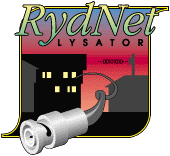
 Most of the information about RydNet is in Swedish.
Most of the information about RydNet is in Swedish.
We think that the RydNet project and the experiences learned from it will prove valuable when planning other information technology projects at the university.
Students at the University of Linköping do not live in dormitories on the campus area. Instead, most of us live in apartments owned by Linköping's public housing company Stångåstaden. The largest area with student apartments is called Ryd. It's two kilometers from the campus area to Ryd, so it's not trivial to connect Ryd to the campus network.
As the houses aren't owned by the university, it was not clear whose responsiblity it was to provide us with a computer network. Instead of waiting for the bureaucracies to react, we started our own student-driven project.
A lot of solutions were discussed during the next years, but nothing really happened. In August 1991, the discussions intensified and Kjell Enblom presented a simple and cheap solution. It was never to be realized, and perhaps we should be grateful for that, as the proposed solution would have been a lot slower than the RydNet we have today.
Some enthusiasts began to plan for an ethernet (10BASE2) network between the different houses. They rasied some money, bought cable, and began to install it between the houses. The first breakthrough came in October 1992, when Kjell Enblom's computer Tekla had contact with Lars Aronsson's Liv.
Now, the major problem was how to connect RydNet to the campus network. Using a leased telephone line was proposed, but that would have been slow and expensive.
The second breakthrough came when a company called LysCom (located in Lysekil on the west coast of Sweden) donated a microwave link to Lysator. In June 1993, the antennas were installed and the link was operational.
The main protocol of RydNet is TCP/IP. Currently the network can route TCP/IP, Appletalk, and IPX.
As of today, RydNet logically consists of a five "class C nets" subnetted from one of the class B nets reserved in RFC 1597. Each subnet corresponds to an ethernet connection at the central switch.
To connect the ethernet segments we use standard multiport repeaters. Earlier we relied almost completely on bridges built from old 286 PC:s, running free bridge software. Some of them may be out there still...
The connection to the campus backbone is through FDDI (100 Mb/s). Until February 27, 1996, we used a microwave link at 0.5 Mb/s.
Because security cannot be guaranteed (anyone could cut a cable and splice his computer into the network), RydNet computers cannot access the Internet directly at the IP level. To reach the rest of the world, you must use proxies or log in on another computer at the university.
Students who own terminals or computers without ethernet connectors can connect to RydNet via a friend's computer.
Please contact us if you want more information about RydNet:
The email address rydnet@lysator.liu.se reaches a group of people involved in the RydNet project.